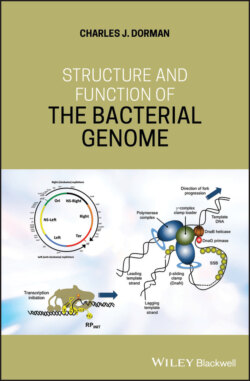Читать книгу Structure and Function of the Bacterial Genome - Charles J. Dorman - Страница 55
1.44 H‐NS Orthologues Encoded by Plasmids and Phage
ОглавлениеCopies of genes encoding H‐NS‐like proteins occur naturally on plasmids, including large, self‐transmissible plasmids (Shintani et al. 2015). These molecules have A+T‐rich DNA and may impose a competitive fitness cost on bacteria that receive them in conjugation by diverting H‐NS from A+T‐rich DNA sites on the chromosome, leading to disruption of the gene expression pattern in the bacterium. By providing its own supply of H‐NS activity, the plasmid can avoid this regulatory disturbance and its associated impact on competitive fitness (Doyle et al. 2007). The R27 plasmid, originally detected in Salmonella, and more recently in S. flexneri 2a 2457T, encodes the H‐NS orthologue Sfh (Beloin et al. 2003a; Deighan et al. 2003). The two proteins exhibit considerable overlaps in their binding sites on the bacterial chromosome. When H‐NS is present, Sfh is restricted to a subset of the sites that it can occupy when H‐NS is removed by inactivation of the hns gene (Dillon et al. 2012). These observations are consistent with Sfh acting as an auxiliary to H‐NS, a role that it shares with StpA. The expression patterns of the three proteins are instructive in this regard: H‐NS is present at a constant level per chromosome throughout the growth cycle, StpA is expressed when the cells are in exponential phase, and Sfh appears at the beginning of stationary phase (Deighan et al. 2003).
H‐NS‐like paralogues encoded by self‐transmissible plasmids (Shintani et al. 2015) and bacteriophage (Skennerton et al. 2011) can downregulate the expression of CRISPR‐cas loci, allowing the mobile genetic element to evade the host immune system (Dillon et al. 2012; Lin et al. 2016; Medina‐Aparicio et al. 2011; Pul et al. 2010). The LysR‐like transcription factor LeuO overcomes H‐NS‐mediated repression of the CRISPR‐cas locus, but the leuO gene is itself silenced by H‐NS, and its paralogues (Dillon et al. 2012; Medina‐Aparicio et al. 2011; Pul et al. 2010). Stochastic upregulation of leuO transcription may provide a mechanism for overcoming silencing of the immunity function in some cells in the population that encounter plasmid or bacteriophage invaders.
